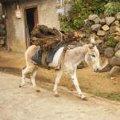This is the VOA Special English Agriculture Report.
A burro is a small donkey. Another way that people say it is BOOR-oh. The name comes from Spanish and, before that, from a Latin term for a small horse. Donkeys are related to horses. Both are part of the equine family.
Burros reach an average height of over a meter. They can weigh more than two hundred twenty-five kilograms. The long-eared animals are often gray with white noses, jaws and undersides. But they can also have coats of red or blue.
Burros are known for their sure footing on mountains while carrying heavy loads. Americans know about them mainly from a history of use as pack animals in Arizona and other areas of the desert Southwest. Gold miners and others imported them to work. Animals that escaped or were freed became the ancestors of burros in the wild today.
But burros are not only good pack animals. They can also help calm and control nervous horses and guard sheep and goats on farms. Robin Rivello from the American Mustang and Burro Association says burros have even protected farm animals against bears.
People may have the idea that burros and donkeys do not like being told what to do. Experts say the animals are not being stubborn. They just like to take their time to consider what they will do.
In the United States, there are breeders who raise and sell burros. Americans can also adopt a burro removed from the wild by the Bureau of Land Management, a federal agency.
People who get a wild burro need to "gentle" the animal. Gentling means training it to accept the human attention needed for care and grooming.
Burros like to clean each other. These desert animals groom themselves with dust. So it is normal for a burro to have some dirt in its coat. A brush can remove hardened mud.
Experts advise owners not to let their burros eat too much. Being overweight can ruin their health.
Robin Rivello says a burro's feet should be cleaned and cared for every six to eight weeks. But she warns owners not to raise the feet as high as with a horse. A burro's legs differ from the legs of a horse. The pain could make the burro kick.
And that's the VOA Special English Agriculture Report, written by Jerilyn Watson. Go to voaspecialenglish.com for transcripts, MP3s and captioned videos of our reports. I'm Karen Leggett.

